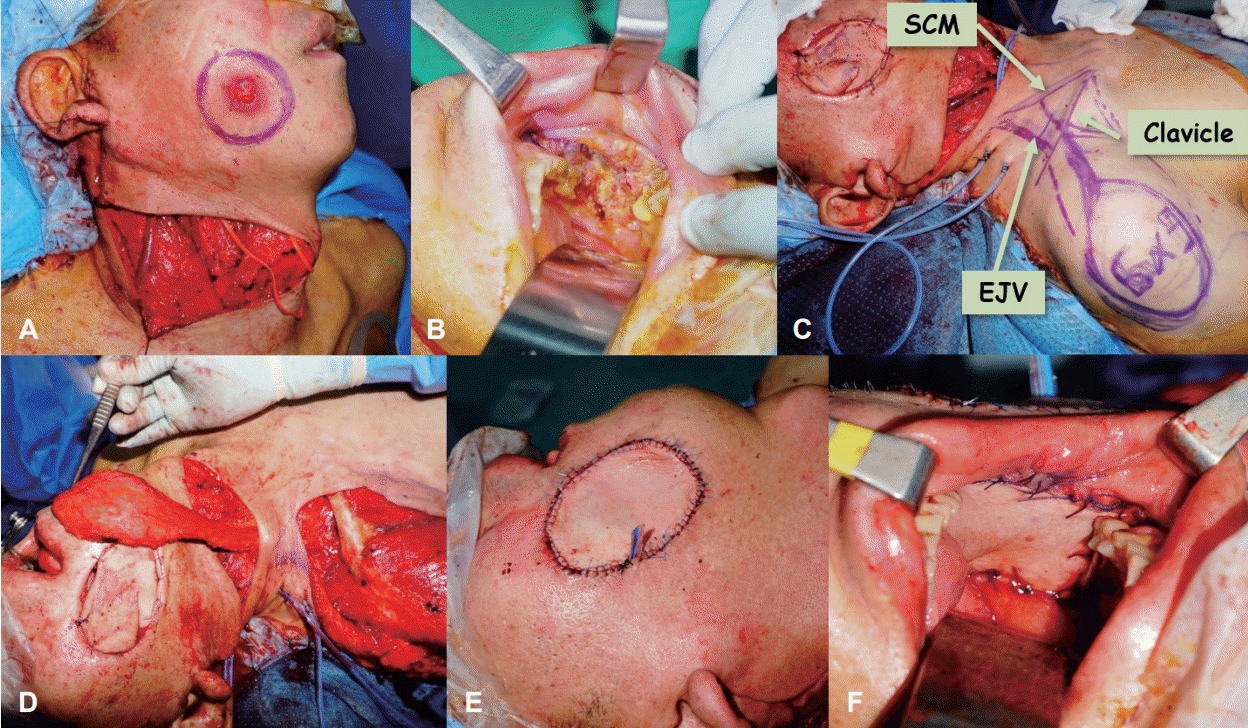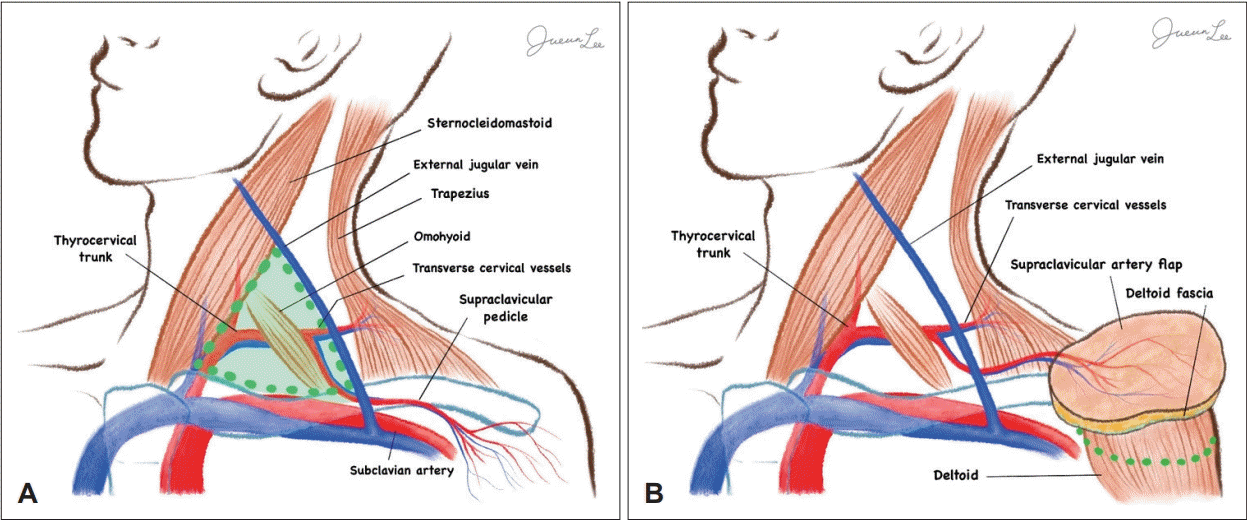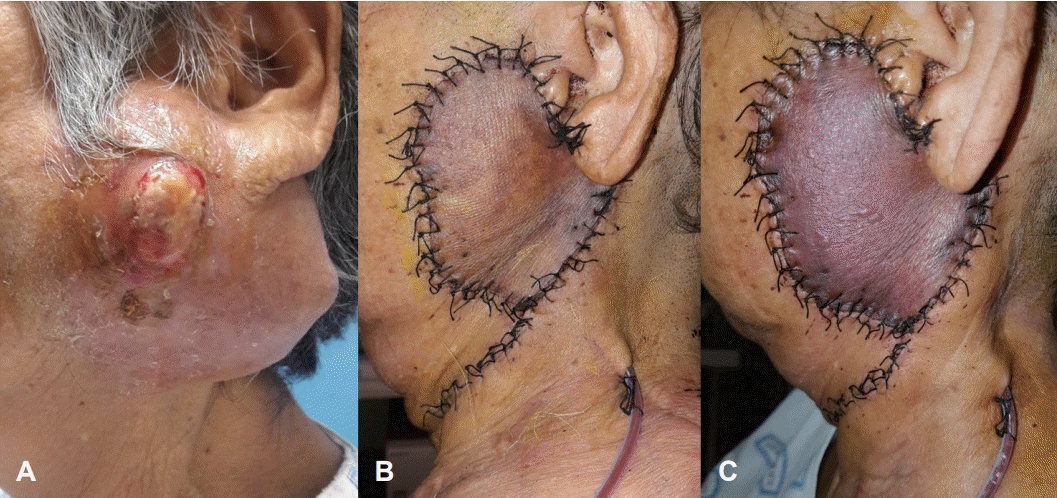쇄골상동맥피판을 이용한 두경부 영역의 재건
Supraclavicular Artery Flap for Head and Neck Reconstruction
Article information
Trans Abstract
Reconstruction of various defects following head and neck surgery is crucial for restoring both function and aesthetics. Over the years, various flap techniques have been developed to meet these demands. The supraclavicular artery flap is a versatile option readily accessible within the same surgical field during head and neck surgery. Its similarity in texture, color, and contour to the facial region makes it particularly useful for reconstructing defects in the neck and lower face. Additionally, its thin and pliable nature, coupled with a moderate volume, renders it suitable for a wide range of applications, including intraoral defects, pharyngeal defects, and contour refinement in facial surgery. In this paper, we present a method for reconstructing defects in the head and neck region using the supraclavicular artery flap, and discuss its utility, advantages, and limitations.
서 론
두경부암의 근치 수술 후 재건은 단순히 결손을 채워 넣는 것을 넘어서 두경부의 복잡한 기능을 최대한 살려야 하며, 안면과 가까워 미용적으로도 보기가 좋아야 한다. 따라서 결손 부위의 위치와 기능, 윤곽에 알맞은 재건을 하기 위한 피판 역시 그 형태와 크기가 적절해야 하며, 다양한 피판술이 개발되어 왔다.
최근에는 다양한 형태로의 조작이 편리하고 공여부 합병증(donor site morbidity)이 상대적으로 낮다는 점에서 요전완피판(radial forearm flap)이나 전외측대퇴피판(anterolateral thigh flap) 등과 같은 유리 피판(free flap)이 보편화되어 사용되고 있다. 하지만 이러한 유리 피판술은 수술 시간과 재원 기간이 연장되고, 숙련된 미세수술의사에 의한 혈관문합술이 요구된다는 단점이 있다. 두경부 영역에서 주로 사용되는 지역 피판(regional flap)에는 대흉근피판(pectoralis flap), 삼각흉근피판(deltopectoral flap), 승모근피판(trapezius flap) 등이 있으나 크기가 커서 다루기가 용이하지 않고, 공여부 합병증의 가능성이 높다.
쇄골상동맥피판(supraclavicular artery flap)은 두부 및 안면 수술 중 같은 시야 안에서 비교적 쉽게 채취할 수 있으며, 안면부 피부와 색깔 및 질감이 유사하여 경부 및 하부 안면 재건 시 유용하게 사용할 수 있는 피판이다[1,2]. 뿐만 아니라, 얇고 유연한 동시에 어느 정도 볼륨을 가지고 있어 구강 내 결손, 인두와 경부 식도 결손, 안면 윤곽 수술 등에도 폭넓게 사용할 수 있다[3-8]. 본 술식은 외국의 교과서와 문헌에서 쉽게 찾아볼 수 있으나, 국내에서 이와 비교해 본 피판에 대한 소개가 드물어 저자들은 이번 논문을 통해 쇄골상동맥피판을 이용한 재건 방법을 소개하고, 그 유용성과 장단점에 대해 고찰해보고자 한다.
방 법
수술 전 준비(Preoperative preparation)
이전 수술로 인한 흉터가 있거나 방사선 조사의 과거력이 있는지 확인하여 혈관경의 혈류가 불안정하거나, 피판의 도안에 간섭이 있는지 검토해야 한다. 피부 구축이 있는 경우 터널을 통해 피판을 이동하였을 때 터널 아래쪽에 있는 혈관경이 압박 받을 수 있다(Fig. 1A) [8]. 따라서 피판을 결손부위에 바로 삽입할 것인지, 피하 터널 아래로 이동시킬 것인지(Fig. 2D and 3C) [2,6], 혹은 피판의 근위부를 관(tube) 형태로 만들어 경부로 가져간 후, 추후 지연 절차로 근위부를 분리할 것인지를 사전에 계획하여야 한다. 중심부 결손을 재건하는 경우 양측 모두 사용이 가능하므로 병변의 반대측 쇄골 상부 영역도 준비해두는 것이 좋다[3].

Case 1. A: The patient presents with radiation necrosis and skin fibrosis following radiation therapy for nasopharyngeal cancer. B: The vascular pedicle within the triangular area bordered by the sternocleidomastoid muscle, external jugular vein, and clavicle is identified using Doppler ultrasound. Due to the proximity of the radiation-induced necrotic defect, the flap was designed slightly shorter than usual. C: Flap elevation begins from the distal end, with careful preservation of the proximal region containing the pedicle. The neck incision line and flap incision are connected to prevent compression of the pedicle by the fibrotic tissue. D: The flap is turned over to ensure it reaches the pharyngeal opening without tension. Subperiosteal dissection is performed in the clavicle area. E: The skin of the flap and the pharyngeal mucosa are aligned for repair. F: Reconstruction of the external skin over the area of radiation necrosis is accomplished using an anterolateral thigh flap, with a successful primary closure of the donor site also depicted.

Case 2. A and B: An invasion of cancer is observed from the buccal mucosa to the cheek. A wide excision including both lesions was planned, followed by reconstruction for the through-and-through defect. C: The vascular pedicle within the triangular area bordered by the sternocleidomastoid muscle, external jugular vein, and clavicle is identified with Doppler ultrasound. The flap is extended to the middle of the deltoid muscle to ensure adequate reach to the buccal mucosa. D: After de-epithelialization of the excess skin above the flap axis, the flap is tunneled towards the buccal mucosa. Subperiosteal dissection was performed in the clavicle area. E and F: The buccal mucosa is reconstructed with a supraclavicular artery flap, and the cheek with a prefabricated radial forearm free flap.

Case 3. A: A patient with a huge locally invasive papillary thyroid carcinoma was planned for reconstruction using a supraclavicular flap following total thyroidectomy. B: The vascular pedicle within the triangular area bordered by the sternocleidomastoid muscle, external jugular vein, and clavicle is identified using Doppler ultrasound. C: For defect reconstruction, the flap is elevated from the distal portion. D: Appearance one week after surgery. The color and texture of the flap are similar to the surrounding neck tissues.
쇄골상동맥피판은 특별히 연령이나 성별에 제한이 있지는 않지만, 여성 환자에서는 공여부를 일차 봉합하게 되면 유방의 위치가 왜곡될 수 있기 때문에 술전에 환자와 상의가 필요하다. 또한 비만한 환자는 과도한 피하조직이 결손 부위의 재건에 적합하지 않을 가능성도 있으므로 사전에 이를 고려하여 계획을 세워야 한다. 흉곽과 쇄골의 위쪽 영역을 사용하기 때문에 사전 팽창(pre-expansion)을 하여 피판을 제작 하기에도 용이하다. 미리 피판의 근막 하에 tissue expander를 삽입하여 피부를 확장한 후 시행하면 넓은 범위의 얇은 피판을 얻을 수 있다[7,9,10].
피판 도안(Flap design)
환자를 앙와위(supine position)로 눕힌 후, 어깨 밑에 접은 포를 받쳐 쇄골 상부 영역이 잘 노출되도록 한다. 재건할 영역을 포함하여 전방으로는 쇄골(clavicle) 하부, 후방으로는 승모근(trapezius muscle)의 전연, 측면은 삼각근(deltoid muscle)을 포함하여 상완 전체가 보이도록 한다.
횡경동맥(transverse cervical artery)은 갑상목동맥(thyrocervical trunk)에서 기시하여 전사각근(anterior scalene muscle)의 표면을 따라 외측을 향해 주행한다. 횡경동맥의 분지인 쇄골상동맥(supraclavicular artery)은 쇄골상동맥피판의 주공급혈관으로, 전방의 흉쇄유돌근(sternocleidomastoid muscle), 하방의 쇄골, 후방의 외경정맥(external jugular vein)으로 둘러싸인 삼각 공간에서 발견할 수 있다(Fig. 1B, 2C, 3A and 4A) [1,5,11]. 이는 견봉쇄골 관절(acromioclavicular joint) 부근에서 분지를 형성하기 전까지 가로로 약 7 cm 가량 주행하며, 주행 경로 내내 1.0-1.5 mm 정도의 굵기를 유지하여 비교적 일관된 혈액 공급을 가진다[12]. 피판의 정맥 배액(venous drainage)은 동맥과 함께 주행하는 동반 정맥(vena comitans)을 이용한다. 외경정맥을 통해 피판의 정맥 배액이 일부 이루어지기도 하나, 이런 경우에는 보통 피판의 회전을 위해 결찰이 필요하다[13]. 휴대용 도플러(handheld Doppler)를 이용하여 쇄골상동맥의 주행을 표시하고 중심축으로 삼아 삼각근 방향으로 피판을 도안한다(Fig. 3B) [14]. 피판의 중심축이 삼각근의 중앙을 지나도록 디자인하는 것이 적절하다. 공여부의 끝은 후상완회선동맥(posterior humeral circumflex artery) 및 흉견봉동맥(thoracoacromial artery)의 견봉분지(acromial branch)와 문합(anastomosis)을 형성한다[12,15]. 이는 피판을 거상하기 위해 결찰해야 하므로 피판을 상완까지 너무 길게 연장하여 채취하면 말단부가 충분한 혈액 공급을 받지 못할 수 있다. 피판이 혈관경을 중심으로 결손부위까지 긴장 없이 회전할 수 있는지 미리 거즈를 이용하여 확인해보면서 도안한다. 너비 4-12 cm, 길이는 20-30 cm까지 채취가 가능하다고 하나, 너비 8 cm를 초과할 경우 공여부의 일차 봉합이 어려워 피부이식이 필요할 수 있다[5,8,14,15].

The anatomical landmarks of the supraclavicular artery flap. A: The supraclavicular pedicle arises from the transverse cervical vessel and is positioned in the triangle outlined by the dorsal edge of the sternocleidomastoid muscle, the external jugular vein, and the medial part of the clavicle. B: The supraclavicular artery nourishes the skin overlying the supraclavicular fossa and the deltoid muscle.
피판 채취(Flap harvest)
피판은 유경(pedicled) 근막피부피판 또는 유리 피판으로도 사용이 가능하나, 여기에서는 유경 피판을 기준으로 설명한다. 도플러로 확인한 혈관경을 근위부에 포함하여 보존해 두고, 나머지 원위부와 전, 후방의 피부를 절개한다. 피판의 원위부 말단에서 후상완회선동맥과 흉견봉동맥의 견봉분지에서 나오는 천공지(perforator)를 만날 수 있으며, 이를 결찰한다[5]. 피판의 거상은 원위부에서 시작하며, 삼각근의 근막하층(subfascial plane)을 따라 피부와 피부하층, 삼각근의 근막을 모두 포함하여 근위부의 쇄골상와(supraclavicular fossa) 방향으로 단극성 전기소작기를 이용하여 진행한다(Fig. 4B) [5,11,14-16]. 삼각근의 근막하층을 따라 박리하면 그보다 천층으로 주행하는 혈관경을 보호하기에 유리하다(perifascial anastomotic network) [17]. 전방에서 후방으로 피판을 거상할 경우 의도치 않게 혈관경을 손상하게 될 수 있으므로 가급적 원위부에서 근위부 방향으로 진행하는 것이 좋다(Fig. 3C) [8,11]. 피판이 쇄골 위를 지나가는 부위에서는 쇄골의 골막을 절개하여 골막하층(subperiosteal plane)으로 박리를 진행하면 혈관경의 손상을 피할 수 있다(Fig. 1D and 2D) [3,18,19]. 근위부 방향으로 피판을 거상하며 진행하면 처음 도플러 신호가 있었던 곳에서 약 8 cm 가량 떨어진 견봉 부근에서 쇄골상동맥을 만날 수 있다. 거상한 피판을 빛에 투광해 보면 혈관경을 눈으로 확인할 수 있어 이를 보호하는 데 도움이 된다[11,15].
쇄골의 내측부터는 도플러나 투광을 이용하여 혈관경의 주행을 확인하면서 혈관의 손상에 유의하여 양극성 전기소작기로 조심스럽게 박리한다[5,8]. 근위부에서 승모근 방향으로 주행하는 척수부신경(spinal accessory nerve)을 만날 수 있으며 신경에 손상을 가하지 않도록 주의하여야 한다[1,11,15]. 피판의 두부 쪽 끝(cranial limit)은 보통 견갑설골근의 하복(inferior belly of omohyoid)이며, 쇄골상동맥은 이 근육보다 심층에서 나와 어깨 방향으로 주행한다. 피판의 회전을 제한하면 이 근육을 절단하여 무방하다[1,15]. 이후 피판의 사용 용도에 따라 근위부 피부를 추가로 절개할 수 있는데, 이는 피부하층까지만 시행하여 하방에 연조직으로 둘러싸인 혈관경을 보존하여야 한다(Fig. 1C) [3]. 가동 범위를 늘리기 위해 혈관경을 무리하게 skeletonization하면 피판의 혈액 공급이 부족해질 수 있어 피하는 것이 좋다[5]. 채취한 피판은 필요한 만큼 탈상피화(de-epithelialization)하여 연조직의 결손부를 채우거나(Fig. 1E, 2D, and 3C), 사전제작(prefabrication)으로 이중 피판섬을 만들어(double island folding) 인두의 양측면을 dual layer로 재건하는 등 다양하게 활용할 수 있다[6,20].
피판의 길이를 연장하기 위해 횡경동맥의 말단부를 결찰하여 횡경동맥의 근위부를 피판경에 포함하는 방법도 있으며, 횡경동맥을 기반으로 한 유리 피판을 제작하여 사용할 수도 있다[13,16]. 피판을 거상하는 중 만나게 되는 신경가지들은 C3, C4에서 유래한 경부신경총(cervical plexus)의 표층피부가지(superficial cutaneous branches)로, 보존하면 피판의 감각 유지에 도움이 되지만 피판의 회전이 제한되는 경우 희생하여야 한다[2,17,18].
공여부 봉합(Donor site closure)
피판의 폭이 7-8 cm을 초과하지 않는 경우에는 대부분 공여부의 양측 피부를 undermining하면 일차 봉합이 가능하다(Fig. 1F and 3D) [8]. 10-16 cm에 이르는 넓은 폭의 피판을 채취한 경우에도 광범위한 undermining을 시행하여 일차 봉합을 시행하였다는 보고도 있다[1,2,16]. 하지만 무리한 일차 봉합은 공여부의 심한 긴장을 유발하여 미용적으로 좋지 못한 흉터를 남길 수 있고, 상완의 움직임을 제한할 수 있으므로 주의해야 한다. 또한 삼각흉근(deltopectoral) 영역을 거상할 때에는 내유동맥(internal mammary artery)의 천공지가 손상되지 않도록 신경 써서 박리하여야 한다. 여성에서는 일차 봉합을 위해 흉부 쪽 피부를 과도하게 거상할 경우 유방의 위치가 올라와 양측이 비대칭이 될 수 있다. 따라서 공여부의 봉합 역시 환자의 체구, 피판의 크기와 모양, 성별, 주변 조직의 상태 등을 종합적으로 고려하여 결정하여야 한다. 저자들은 폭이 8 cm을 넘는 공여부의 결손에는 피부이식을 권유한다.
술후 관리(Postoperative care)
혈관경 주변에 혈액이나 체액이 저류하면 혈관경을 압박할 수 있어 적절한 배액관을 삽입한다. 수술 후 초기에는 침대의 머리 쪽은 약간 세워 두고, 환자가 목을 비틀거나 돌리지 않도록 주의한다. 배액관을 제거하기 전까지는 동측의 팔을 많이 움직이지 않도록 한다.
고 찰
두경부 결손의 재건을 위해서는 기능적, 해부학적인 측면을 고려하여 삼차원적으로 디자인하여야 한다. 두경부 영역에서 자주 사용되는 지역 피판으로는 대흉근피판, 삼각흉근피판, 승모근피판이나 광배근피판이 있다. 이들은 큰 근육을 포함하는 경우가 많아 조작이 불편하고, 회전에 제한이 있으며, 경부와 하부 안면 재건에 사용하기에는 너무 비대하여 적절한 윤곽을 만들기 어렵다[1,2,5,8,11]. 단순 피부이식은 재건에 필요한 볼륨이 부족하고, 두경부의 주요 혈관들이 노출되었을 경우 혈관경이 있는 피판과 달리 이들을 덮어 보호할 수 있는 튼튼한 조직이 없다. 최근에는 미세수술의 발달에 힘입어, two-team approach가 가능하고 공여부 합병증을 줄일 수 있는 유리 피판이 널리 이용되고 있다. 하지만 유리 피판술은 술자가 미세수술 술기를 숙달하기까지 학습 기간이 길며, 일반적으로 지역 피판에 비해 수술시간과 재원기간이 연장된다는 단점이 있다. 또한 방사선 조사를 받았거나 경부 혈관이 좋지 못할 경우 혈관 문합에서 상당한 도전이 있을 수 있다.
쇄골상동맥피판은 두경부결손 재건 시 가장 유용하게 사용할 수 있는 지역 피판 중 하나이다. 이는 1979년 Lamberty [12]에 의해 처음으로 사체 해부를 통한 혈관경과 피판의 탐구가 이루어졌으나, 1997년 Pallua 등[15]이 화상으로 인한 mentosternal 구축의 재건에 사용한 증례를 보고한 이후에야 널리 이용되기 시작했다. 과거에는 원위부 말단 괴사가 자주 발생하는 단점이 있어 외면되었으나, 최근 쇄골상동맥피판의 해부학적 구조와 한계에 대한 이해가 높아지며 다시 자주 사용되고 있다[16].
이는 비교적 얇고 다루기 쉬운 데다가 두경부 결손부의 피부와 색깔과 질감이 유사하여 미용적으로 우수하다(Fig. 3D) [7,10,11]. 또한 모낭이 없어 구강이나 인두 점막 등 재건시에도 유리하지만 남성의 턱과 같이 털이 있는 곳의 재건에는 오히려 단점이 될 수도 있다. 유경 피판으로 사용할 시 미세수술 전문가 없이도 가능하며, 채취 부위에 주요 신경이나 근육을 포함하지 않기 때문에 공여부 합병증 또한 매우 적은 편에 속한다. 경부림프절 절제 후에도 보통은 횡경동맥과 쇄골 상동맥은 보존되며, 방사선 조사 시에도 기원 혈관인 갑상목 동맥(thyrocervical trunk)은 쇄골에 의해 보호를 받게 된다. 하지만 앞선 수술이나 방사선치료 후에는 혈관경을 사용하기 어려울 수 있기 때문에 술전에 미리 CT angiography나 MR angiography 등의 영상검사를 시행하여 혈관경의 개방성을 확인하는 것이 좋다[8].
저자들은 방사선 괴사로 인한 결손(Fig. 1A)이나, 협점막암에서 피부를 포함한 광범위 절제를 시행하여 through-andthrough defect가 발생하였을 때(Fig. 2A and B) 유리 피판과 쇄골상동맥피판을 동시에 사용하여 이를 안팎으로 재건함으로써 좋은 결과를 얻었다(Fig. 2E and F). 물론 throughand-through defect에서 쇄골상동맥피판 단독으로 이중 피판섬을 만들어 결손부의 안팎을 동시에 재건하는 방법도 사용할 수 있으나, 피판을 접었을 때 원위측 피판섬의 정맥 울혈과 같은 혈액 공급에 문제가 발생할 수 있고, 넓은 범위의 피부 피판이 필요하여 공여부의 일차 봉합이 어려울 수도 있다. 또한 tissue expander를 미리 삽입하는 방법은 공여부의 조직이 확장될 시간이 필요하기 때문에 악성 종양의 절제 시기를 지연시킬 우려가 있다. 특히, 이전 방사선 조사로 혈관경을 문합에 이용할 혈관이 부족하여 여러 개의 유리 피판을 사용하기 어려운 경우에 쇄골상동맥피판과 유리 피판을 동시에 사용한다면 two-team approach를 통해 수술 시간과 술자의 피로도를 줄이면서 우수한 결과를 얻을 수 있다.
저자의 경험상 쇄골상동맥피판은 몇 가지 제한점을 보이기도 한다. 첫째, 피판의 angioderm이 일정치 않아 피판을 일정한 길이로 획득하기 어렵다. 방법에서 언급한 바와 같이 20-30 cm 정도 길이로 획득이 가능하다고 보고되고 있으나, 원위부의 임의 피판(random pattern flap) 부위는 괴사 가능성이 있음을 기억해야 한다. 둘째, 동맥 주행은 비교적 일정한 편이나, 정맥 배액은 횡경정맥을 거쳐 내경정맥으로 배액되기도 하고, 외경정맥을 통해 배액되기도 하는 등 일정하지 않아 환자에 따라 울혈(congestion)이 발생하기 쉽다는 점이다. 저자들도 이하선의 다형선종(pleomorphic adenoma) 환자에서 피부를 포함한 광범위한 이하선 절제술 후 쇄골상동맥피판을 이용한 재건술을 시행하였으나, 울혈로 인한 피판의 소실을 경험하기도 하였다(Fig. 5). 셋째, 쇄골 아래로는 혈관경이 피하로 주행하기 때문에, 이에 대한 숙지가 부족한 초심자의 경우 피판을 거상하는 중 혈관경을 손상시킬 위험이 있다.

Case 4. A: A patient with pleomorphic adenoma involving the skin was scheduled for reconstruction using a supraclavicular flap after parotidectomy. B: At 48 hours postoperatively, the color of the flap began to change to a slightly dark purple. C: At 72 hours postoperatively, the color of the flap further deepened, and swelling was observed, raising suspicion of venous congestion.
하지만, 쇄골상동맥피판은 위에서 설명한 다른 피판들이 갖는 문제점들을 많이 해결할 수 있다. 대략 1시간 이내에 비교적 간단히 채취가 가능하고[1,3-5,11], 쇄골 상부에 pivot point가 있어 두경부 영역을 재건하는 데에는 삼각대흉피판이나 대흉근피판에 비해 더 나은 회전을 보인다[1]. 하지만 쇄골상동맥피판은 근육을 포함하지 않아 많은 볼륨이 필요한 큰 결손부를 재건하는 데에는 적절하지 않을 수 있다[1]. 원위부의 관류장애로 인한 괴사 가능성이 있음을 이해하고 너무 긴 길이의 피판을 무리하게 시도하지만 않는다면, 얇고 적당한 볼륨이 필요한 두경부의 결손부위를 재건하는 데 훌륭한 선택이 될 수 있다. 이에 저자들은 쇄골상동맥피판의 일반적인 사용법을 소개하며, 적응이 되는 환자에게 사용을 적극 권유하는 바이다. 본 연구는 기관연구윤리심의위원회(Institutional Review Board)의 심사결과 면제를 받았다(KC23ZASI0934).
Acknowledgements
None
Notes
Author contributions
Conceptualization: Sang-Yeon Kim, Oh-Hyeong Lee, Dong-il Sun. Data curation: Sang-Yeon Kim, Oh-Hyeong Lee. Formal analysis: Oh-Hyeong Lee, Jooin Bang, Geun-Jeon Kim. Supervision: Dong-il Sun, Sang-Yeon Kim. Visualization: Ju Eun Lee. Writing—original draft: Oh-Hyeong Lee. Writing—review & editing: SangYeon Kim.
